Table of Contents: Intro & 1920; 1921-1923; 1924-1927; 1928-1932; 1933-1935; 1936-1939; 1940-1945; 1946-1949; 1950-1953; 1954-1956; 1957-1959; 1960-1963; 1964-1966; 1967-1969; 1970-1973; 1974-1976; 1977-1979; 1980-1983; 1984-1986; 1987-1989; 1990-1993; 1994-1996; 1997-1999; 2000-2003; 2004-2006; 2007-2009; 2010; 2011; 2012; 2013; 2014; 2015; 2016; 2017; 2018; 2019; Recap & 2020; 2021; 2022
This week, the 100 Years of Buggy History series takes a look at the early 1960s. We see the Golden Goose be golden twice more, before, like all empires, the great reign of the ATO Empire falls. Plus, we see the birth of SAE’s 2-wheel bike, a mix of other interesting designs and methods for increasing speed, and the Men’s Dorms make history.
1960
Raceday: Prelims on Friday, May 6 at 10:00am; Finals on Saturday, May 7 at 10:00am
Sweepstakes Committee: Unknown
Race Results: (1) ATO – Golden Goose (2:34.5); (2) Men’s Dorms (2:36.0); (3) PiKA (2:41.8)
Design Comp: (1) PhiKap; (2) PiKA
Weather: Sunny, 71-78 Degrees on Friday; Rain, 58 Degrees on Saturday
After a one year absence, ATO reclaims their spot on top, plus the Men’s Dorms make history and rain messes with the results.
- Spring Carnival Becoming Too Much? It was, and continues to be, a somewhat common refrain in the pages of the Tartan that Spring Carnival takes up too much time and money. But in late 1959, Student Government took it to a new level. Throughout multiple Student Congress meetings, they discussed ways to “fix” Spring Carnival, as they all agreed that preparation for Carnival was too time consuming and expensive. There was also an argument made that Carnival was for the Greeks, and that the independent community did not derive much enjoyment from the weekend. However, it doesn’t look like any decisions were ever made about how to fix these issues; it was merely something for people to complain about.
- ATO Regains Their Form. It was a warm, sunny day on Friday as the teams took to the course. And ATO was intent on proving that they belonged back on top, a year after their unfortunate Pacing DQ. We don’t know exactly how many teams entered the race in 1960, but ATO wasted no time showing that they were in a class of their own. With Golden Goose in tow, ATO blitzed their way to a top Prelim time of 2:27. Lagging behind in 2nd during the Prelims was PiKA in 2:32.4.
- Men’s Dorms Makes History. The biggest surprise of Raceday 1960, however, came courtesy of the Men’s Dorms. For the first time in history, an independent organization made the Finals! With a strong showing on Friday of 2:35.4, the Men’s Dorms snagged the third and final spot in the Finals.
- Rain Hinders Finals. Saturday’s Finals had some unanticipated drama in the form of weather. Rain fell on Saturday morning, leaving the course damp. But the races went on anyway! The result was a significantly slower Finals. ATO maintained their lead and earned their 7th victory in 8 years, but they did so with a final time of 2:34.5, 7.5 seconds slower than their Prelim time. The Men’s Dorms, meanwhile, moved up to 2nd, running roughly equal to their Prelim performance with a 2:36.0. PiKA, who may have been hampered by wheel troubles in the wet weather, had to settle for 3rd with a time of 2:41.8.
- DU Taps a Unique Buggy. DU rolled out one of the most unique, and most memorable, buggies in history in 1960. It wasn’t a useful buggy on the course, but it may have been a useful buggy at the victory celebration later! The buggy was essentially a keg of beer mounted on four wheels. As the May 11, 1960 Tartan writes, “from the records of the time recorded it looks like the DUs must have tapped that keg some place near [Phipps] and then started the race again.” The Tartan also remarked that SAE’s buggy finished well behind the leads “in spite of a 3 horsepower motor and a set of blue headlights.”
- 1960 Photos. Below are some photos from 1960:
1961
Raceday: Prelims on Friday, May 5 at 10:00am; Finals on Saturday, May 6
Sweepstakes Committee: Unknown
Race Results: (1) ATO – Golden Goose (2:27.2); (2) PiKA – Shark (2:32.8); (3) SAE – Maroon (2:33.8)
Design Comp: (1) ATO – Golden Goose; (2) Men’s Dorms – #11
Weather: Unknown
Well, this is awkward. In case you couldn’t tell from the “Unknowns” above, the 1961 Tartans are missing from the digital archives, and there’s very little other written record (Update from 2022: They’re missing from the DIGITAL archives, but the Tartan has physical archives and guess what? We found them!). So we don’t know much outside of the top 3 results (but YOU might…so if you have info about 1961, let us know!)
- SAE Cycles Through Designs… The big news in 1961 came from SAE. 2 wheeled buggies had been seen in the past on rare occasions, but in 1961 SAE rolled out their 2-wheeled bicycle-style buggy. The buggy was several seconds slower than other buggies in the freeroll, but it more than made up that time on the hills thanks to its light weight, and finished 3rd in its debut, marking SAE’s first time in the Top 3 since 1926.
- …And Scares Off Opponents. Of course, not every team was thrilled about SAE’s 2-wheeled design. Originally, SAE’s bike was scheduled to compete in Heat 3 against ATO and DU. However, those two organizations objected to SAE’s inclusion in their heat over concerns about the “radical” new design. Sweepstakes obliged and moved SAE’s bike to a special solo heat at the end of the Prelims.
- Heat Schedule. Speaking of heats, thanks to our discovery of the 1961 Tartan, we have the Prelims heats for the year. They were:
- Heat 1 (10:00am): PiKA’s Shark (Lane 1), PhiKap’s #77 (Lane 2), Theta Xi’s Pi (Lane 3)
- Heat 2 (10:10am): KapSig (Lane 1), Beta Sigma Rho (Lane 2), SigNu (Lane 3)
- Heat 3 (10:20am): ATO (Lane 2), DU’s Old Gold (Lane 3)
- Heat 4 (10:30am): Beta (Lane 1), PhiKap’s Salamander (Lane 2), SigNu (Lane 3)
- Heat 5 (10:40am): PiKA’s Cheetah (Lane 1), DTD (Lane 2), Men’s Dorms #11 (Lane 3)
- Heat 6 (10:50am): ATO (Lane 1), Beta (Lane 2), KapSig (Lane 3)
- Heat 7 (11:00am): SAE’s Maroon
ATO’s Newest Buggy Acquits Itself. Andy II made its debut on the course back in 1959, and it would have won if not for a Pacing DQ. In 1960, ATO sent their A team back to Golden Goose, but in 1961 Andy II got another try. And it didn’t disappoint, as ATO with Andy II crossed the finish line in front, picking up the org’s 8th win in 9 years. EDIT: Per the 1961 Tartan, the winning buggy was actually Golden Goose, adding another win to its record. The ATO team consisted of Larry Ritchi, Al Patz, Bob Nowak, Mugsie Stevens, and Bill Novack, and was driven by Doug Sanderson. PiKA, with Shark/S-1, finished 2nd with a time of 2:32.8, behind the pushing of Bill Elsey, Jim Jubenski, Jim Sharkey, Bob Wolfe, and Bob Meyn and the driving of Lou Caramella. SAE’s Bike pulled off a shocking upset, finishing 3rd with a time of 2:33.8, with Paul Pheneger, Bob Miller, Frank Jones, Bill Faircloth and Deates Lahanas providing the pushing and Curt Eaves doing the driving.
- ATO Pulls off the Double. Winning the race is one thing, but ATO took it one step further in 1961. With a rebuilt back end and a new single pushbar designed by Ron Pellman to replace the old double pushbar, ATO entered Golden Goose into the Design Competition and the champion buggy won, taking home its third Design Trophy and giving ATO the Racing-Design Double. Men’s Dorms would put up a great showing in Design as well, with their powder-blue metallic buggy taking 2nd and earning the dorms their first ever Design Comp trophy.
- 1961 Photos. We may not have much information, but we do have some photos! If you can ID the unknown buggies, let us know.
1962
Raceday: Prelims on Friday, May 11 at 10:00am; Finals on Saturday, May 12 at 10:00am
Sweepstakes Committee: Bob Forbes (ATO)
Race Results: (1) ATO – Golden Goose (2:26.4); (2) PiKA – Shark/S-1 (2:29.8); (3) SAE – Bike (2:31.8)
Design Comp: (1) Beta; (2) ATO
Weather: Sunny, 58-67 Degrees on Friday; Cloudy, 65-68 Degrees on Saturday
Nobody knew it then, but 1962 would see ATO win the race for the final time in its history, bringing its epic 10 year run to a close.
- WRCT Back On The Course. We’ve covered some of the broadcasting in years past, and we don’t know if WRCT had been broadcasting the races in the intervening years. But in 1962, WRCT was back on the course and broadcasting the races on both days.
- Prelim Heats. Heat selection was completed on March 7, 1962, a full 2 months (!) before Raceday. In addition, for the first time on record, each buggy was identified by a specified number, providing us with a slightly easier way to identify buggies (of course, that only works if the buggies included their number on them; not all seemed to, or at least the numbers are not always visible in the photos). The numbers appear to have been selected by the organizations themselves, and some of the numbers would eventually stick and become the names of these buggies. 19 buggies entered the race. The full heat list, with lanes, is as follows:
- (Lane 1) PiKA (#2); (2) ATO (#69); (3) SigNu (#3)
- (1) SAE (#6); (2) Beta (#0); (3) Men’s Dorms (#11)
- (1) DU (#28); (2) PhiKap (#77); (3) DTD (#8)
- (1) DU (#28.5); (2) SigNu (#22); (3) Beta (#00)
- (1) PiKA (#17); (2) Theta Xi (#3.14); (3) ATO (#44)
- (1) PhiKap (#23); (2) Beta Sigma Rho (#88); (3) NONE
- (1) KapSig (#18); (2) NONE; (3) SAE (#7)
- Not Everyone Started. Since the heat selections were conducted so far in advance, it’s no surprise that not everyone made it. Ultimately, 4 teams had to scratch from rolling on Raceday. DTD’s #8, SigNu’s #22, DU’s #28.5, and KapSig’s #18 were all scratched from Raceday, leaving just 15 to compete.
- One Fraternity’s Poor Design. Buggies in the 1960s tended to be particularly small and cramped (just take a look at the Golden Goose). This may have helped with speed and aerodynamics, but not driver ability. The April 1964 edition of the Carnegie Technical tells a tale that in 1962, one fraternity’s designer forgot to put padding in the cockpit of the buggy. The incessant pounding and heat caused the driver to black out and the buggy careened into a curve. The driver was uninjured in the crash. The article does not specify the organization involved, but only 1 buggy was a DNF in 1962 – DU’s #28. So we can only assume that this was a DU design flaw.
- Tires are…cooled? Nowadays, most teams improve their speeds by heating tires (a strategy that began as early as the 1950s). But the August 1963 edition of Road and Track Magazine, which included an article called “Grand Prix of Pittsburgh”, noted that in 1962, an unknown fraternity actually tried to cool their tires. The fraternity used dry ice to cool the tires in an attempt to eliminate the energy lost from the internal friction of the flexing rubber. Without knowing which team it was, we don’t know how successful this turned out to be. But our guess? Not very.
- Prelim Results. Not only do we know the heats, but we also have the full prelim results! These will be added to the History tab once we’ve updated the backend databases, but until then we’re including them here. It’s interesting to see how the heats weren’t exactly spaced out, and Heat 1 appears to have been the top teams, and teams got progressively slower as the heats got later; in fact, the 2 of the top 3 buggies came out of Heat 1.
- ATO – Golden Goose (#69) (2:26.4)
- SAE – Bike (#6) (2:33.1)
- PiKA – Shark/S-1 (#2) (2:33.9)
- ATO – Andy II (#44) (2:35.5)
- SAE – #7 (2:39.1)
- Beta – #00 (2:41.4)
- SigNu – #3 (2:43.5)
- Beta – #0 (2:44.2)
- PhiKap – #23 (2:44.2)
- PhiKap – #77 (2:47.4)
- PiKA – #17 (2:50.2)
- Theta Xi – #3.14 (2:54.5)
- Beta Sigma Rho – #88 (2:56.1)
- Men’s Dorms – #11 (3:02.1)
- Finals Brought Minimal Excitement. Whatever excitement existed during the Finals disappeared once the buggies hit the freeroll. The front hills stayed relatively close, but ATO’s Golden Goose opened up in the freeroll and pulled far ahead of its opponents. PiKA’s Shark was second and closed the gap a little on the backhills, but never got that close, with ATO ultimately winning by approximately 15 yards (a 3 second gap). PiKA moved up from the Prelims and finished 2nd, while SAE’s Bike was another couple of seconds back in 3rd.
- 1962 Photos. Below are some photos from 1962:
1963
Raceday: Prelims on Friday, May 3 at 10:00am; Finals on Saturday, May 4 at 10:00am
Sweepstakes Committee: Blaine Cliver (SigNu)
Race Results: (1) PiKA – Shark (2:31.75); (2) SAE – Maroon (2:33.2); (3) Beta (2:34.2)
Design Comp: (1) SigNu – Lizard; (2) PhiKap – Snorpus
Weather: Sunny, 66-71 Degrees on Friday; Sunny, 71-75 Degrees on Saturday
1963 began the fall of the ATO Empire, with PiKA around to pick up the pieces. It also included a new brake test, yet another vehicle on the course, and a very interesting exhibition heat.
- New Brake Test Introduced. Brakes were not a new buggy requirement in 1963, but Sweepstakes did implement a new method of testing the brakes. During Design Competition (which began at 7:30am on Friday, May 3), each buggy was put on a 15 degree plywood ramp and was required to remain stationary when the brakes were applied. Of the 15 buggies that reportedly entered on Raceday, 6 of them failed this test after 2 attempts. Luckily for them, the test was administered hours before the race, so 5 of the 6 were able to repair their braking systems and pass the test prior to the start of Prelims. The 6th buggy used a drag brake, which was ineffective when put on plywood but worked when the buggy was placed on pavement, and therefore it was granted an exemption and allowed to race.
- Men’s Dorms Incident. According to the April 1964 Carnegie Technical, the Men’s Dorms had an issue during early morning practices in 1963. During the freeroll, the buggy encountered an issue and the steering sheared off, causing the buggy to crash “through the turn and sail out into the Schenley Park underbrush.” The driver was thankfully uninjured.
- Major Upset in Prelims. For the first time in several years, the Prelims were the source of major excitement. ATO’s Golden Goose was easily expected to earn ATO its 10th win in 11 years. And as the buggy traveled through the Freeroll in the 6th and final Prelim heat of the day, it looked like that would be the case, as it was putting up an “extraordinary” time. But with greater speed comes greater risk, and as the buggy turned into the Chute, it carried a little too much speed and spun out. The buggy made a 540 degree spin and sheared rubber off of its wheels. Unlike today, the buggy was still allowed to continue, but the Hill 3 pusher, who was waiting in his normal spot, had to run down to the chute to pick up the buggy, costing ATO a significant amount of time. The result is that ATO’s Golden Goose finished last (of the finishing buggies), in a time of 3:11.45. DU, meanwhile, tried out a special heated oil that was applied to their bearings moments before the race to improve their speed, but it doesn’t appear to have helped enough to advance them to the Finals, as they only finished 4th.
- More Vehicle Scares. PiKA’s Shark was cruising along in its Prelim heat, well ahead of the competition, when suddenly it wasn’t in the lead anymore! According to the April 1964 Carnegie Technical, a car had slipped through the Panther Hollow Bridge barricade and drove out in front of the buggy. Driver Ed Escallon was forced to swerve in order to avoid the car, and the swerve caused at least one tire to come off the ground. The buggy traveled 50 feet before it was able to get back on 4 wheels.
- Prelim Results. Of the 15 buggies that supposedly started, only 11 buggies ended up actually finishing the Prelims. We don’t know what happened to the other 4, but we do know the full results of the 11 that finished. And as surprising as it was to not see ATO atop the leaderboard, if may have been even more surprising to see who was. The Prelim results are as follows:
- Beta (00) – 2:34.1
- PiKA (Shark/S-1) – 2:34.4
- SAE (Bike) – 2:34.53
- DU – 2:36.4
- ATO (Andy II) – 2:39.8
- SigNu (Lizard) – 2:42.15
- PiKA (Cheetah) – 2:44.6
- DU – 2:47.2
- PhiKap – 2:56.4
- SigNu – 2:57.57
- ATO (Golden Goose) – 3:11.45
- As a note, we have a photo of DTD on the backhills, but they don’t appear in the final results, so it seems likely that they were DQ’d for some unknown reason.
- Finals Results. The Finals of 1963 were very exciting, which isn’t surprising given the 0.5 seconds separating the 3 teams in Prelims. PiKA’s Shark ended up victorious, and it seems as though they had the lead the whole way. The battle for 2nd, however, was incredibly tight. Beta’s 3-wheeled “00” led through the freeroll, but SAE’s 2-wheeled bike had the edge on the hills. SAE’s Hill 5 pusher managed to get their buggy in front of Beta’s about 100 yards from the finish line, and led to SAE taking 2nd, with Beta falling to 3rd.
- SigNu’s Impressive Design. It’s a bit of a surprise given the name, but Lizard was not green in 1963; it was actually described as a candy red apple-colored buggy. But it wasn’t just the color that made it so interesting; SigNu built an entirely new suspension system for the buggy, and the tires were specially designed and made of fire truck rubber. These unique features were enough to earn Lizard its first Design Competition win.
- We have an Exhibition Heat! With Women!. The Tartan never mentions a special exhibition heat occurring in 1963, focusing instead on the official results. But Road & Track Magazine was interested in the entire day, and so it didn’t go unnoticed when a motley crew of people and teams decided to put together a “comical” heat. According to the article, “to make the race more fun and less intense there was one heat for comical buggies.” The three teams were Kappa Kappa Gamma, who borrowed a practice buggy from PiKA, TriDelt, who decorated a wheelbarrow, and SigNu, who entered a “sailboat” made from an old bathtub, with concrete wheels and a sail. SigNu was in front and looked like they were going to win, but apparently the concrete wheels “disintegrated” just 10 feet from the finish line, and the sailboat was too heavy to drag across the finish line without wheels. As a result, Kappa passed them and emerged victorious. You may think this exhibition race was fake (maybe a belated April Fools’ joke), and I questioned whether it was legit as well. Luckily, the Road & Track Magazine decided to provide photographic evidence of SigNu’s “buggy”.
- 1963 Photos. Between the Tartan, the Thistle, the August 1963 Road & Track Magazine’s “Grand Prix of Pittsburgh”, the April 1964 Carnegie Technical’s “Carnegie’s Grand Prix”, and our gallery, we’ve got a ton of photos from 1963:
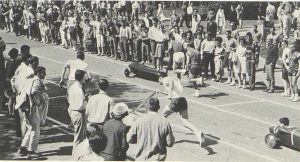

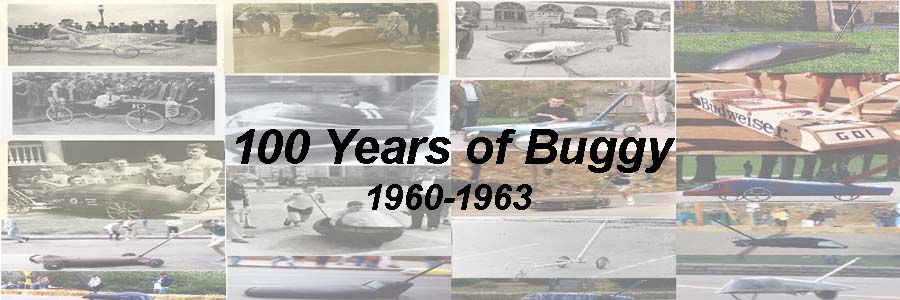
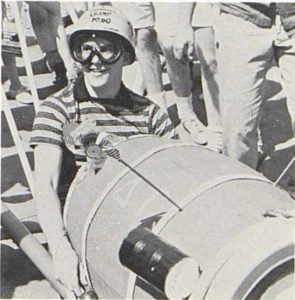
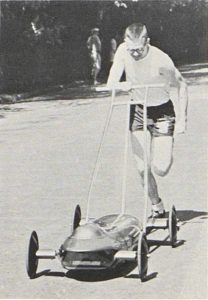
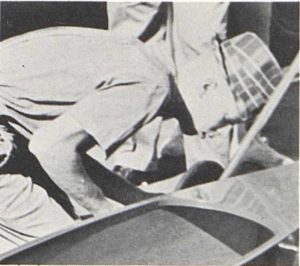
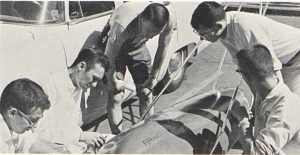
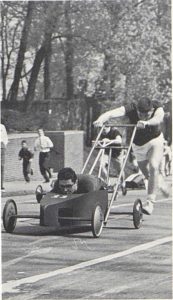
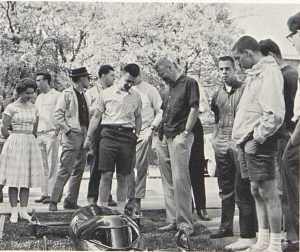

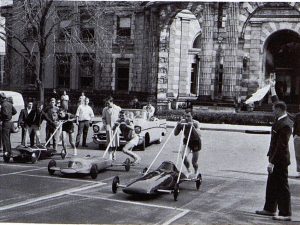

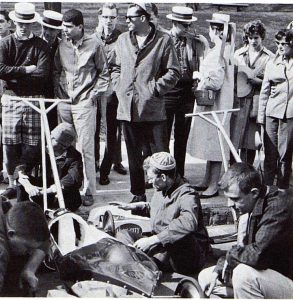
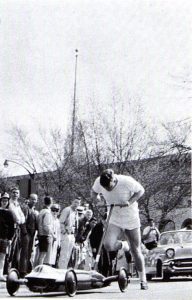
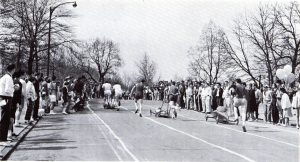
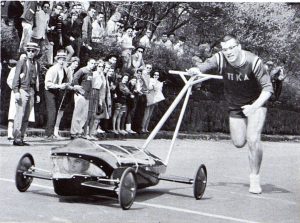

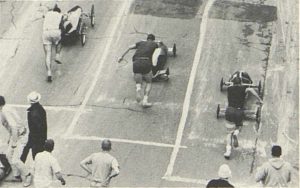
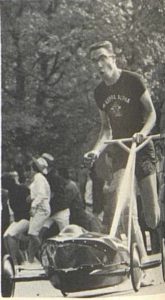
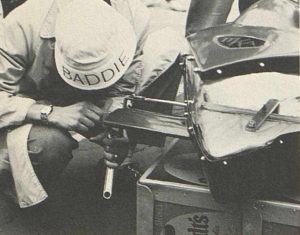

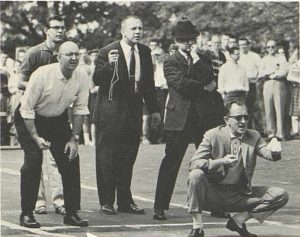
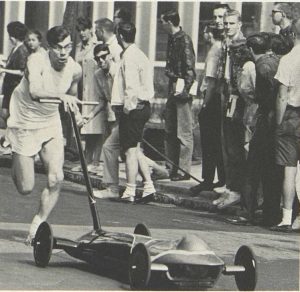
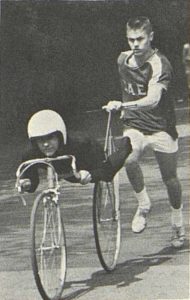
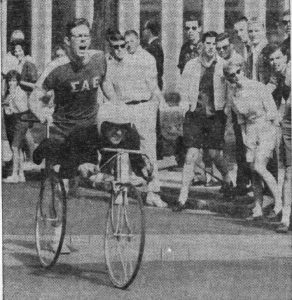
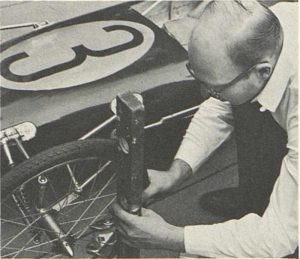
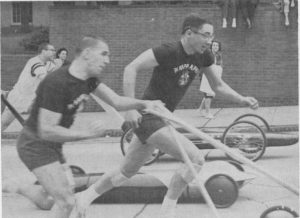

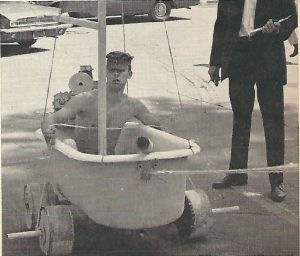
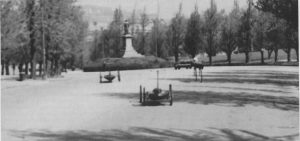

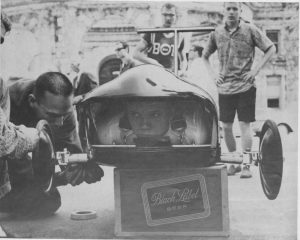
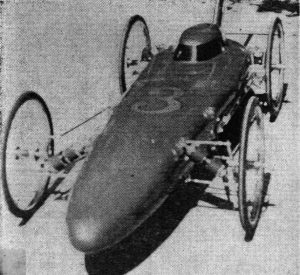
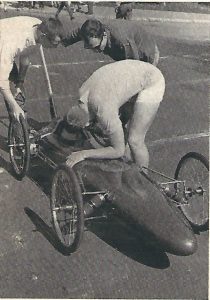
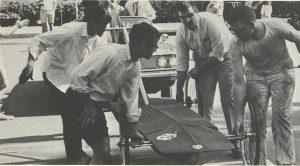



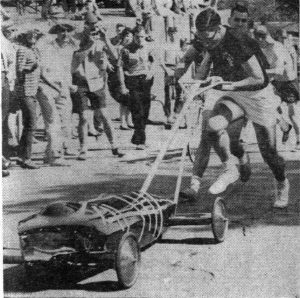
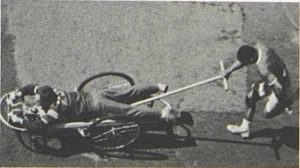
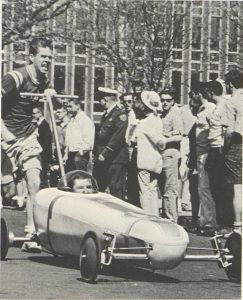


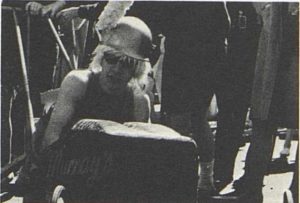

Elmo Zoneball says:
The SAE two-wheelers (“bikes”) — there were two of them — were (so I was told) designed and built by A. J. Eggenberger and Bill Faircloth.
As I recall, one had a steel center tube, the other, aluminum. One of them was named “Arnold” (for reasons no one in the ’70s seemed to know.)
They were extremely stable, albeit slow, in freeroll. But because of the long wheelbase, they didn’t handle like a normal bicycle at slow speeds, when being pushed, for example. Drivers complained about how difficult it was to keep them under control at slow speeds.
Paul Gritt says:
I was on the Dorm team during this period. After graduation I gat a chance to come back as a judge from Chrysler Engineering. Bucket list item
Paul Gritt E 65.
Bill Dillon says:
Paul,
Good to see your comment. I was a driver for PiKA back in the 70’s, and return every year for SPring Carnival and fraternity reunion. Hope to see you there!
Best regards,
Bill Dillon
Mark Estes says:
What you will note in most of these photos is that, 2 wheeled buggies aside, there is a convergence in wheels towards the soap box derby wheel. These were 12-inch in diameter. Stock versions typically were composed with 2 spin formed (or stamped) steel bowls spot welded together near the rim to form a wheel shape. This design trapped a rubber tire between the 2 sides of the wheel. A crude bearing seat/hole allowed snap ring bearings to be added. Variants of these we used at the sharp end of the field with a few exceptions through the early 90s. Some years of derby rubber were better than others and these were sought out vigorously. Alternative tires were also in play, notably those made by Goodyear. These wheels could be fast but were notably heavy. Successful efforts were made to add better bearing seats and reduce the mass by several teams. These wheels eventually gave way to lighter pneumatic wheel chair racing wheels and smaller rubber (PKA) and urethane ( ex. Xootr) sized wheels. Some teams (ATO was first I believe) figured out that heating the rubber made for reduced rolling resistance. Others found chemical methods to reduce rolling resistance.